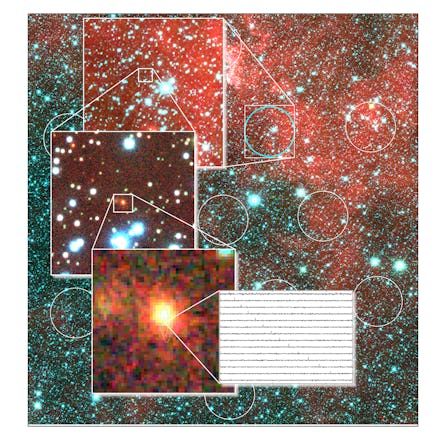Scientists Finally Figured Out the Origin of Those Mysterious Sounds in Space

Mysterious short bursts of radio waves called fast radio bursts (FRBs) flying through space have baffled astronomers since the first one was detected in 2001.
Since then, only 17 of these strange signals have ever been recorded. They last only a few milliseconds, so it's been impossible to trace them back to their sources.
That is, until astronomers decided to rig an alarm system to catch the next FRB with the Parkes Radio Telescope in Australia. On April 18, Parkes picked up a signal. That signal was immediately fed into a supercomputer that sent out an alert around the world.
"A decade ago, we weren't really looking for them [FRBs] — and also our ability to handle the data and to search it in a reasonable time was significantly poorer," Evan Keane, a project scientist at the Square Kilometer Array Organization, told the BBC. "Whereas with this one, I was awoken by my phone going crazy a few seconds after it happened, saying, 'Evan, wake up! There was an FRB!'"
Even though the signal itself lasted only a few milliseconds, the afterglow stuck around for six days. Astronomers were able to use optical telescopes to zero in on that afterglow and follow it all the way to a galaxy 6 billion light-years away, reported the Washington Post. (The research is published in the journal Nature.)
They may have found the source, but it's still a mystery what caused the actual FRB. According to the Washington Post, the researchers think it might have come from the violent collision of two dead stars. But there are many other theories about what might cause FRBs. Now that we have a way to more closely track them, astronomers might finally find some answers.
There's another profound implication that comes from this research. The astronomers inadvertently figured out a way to measure the weight of the universe, Keane told the BBC.
Because they got an optical image of the galaxy from which the FRB originated, astronomers can measure how far away it is based on how much of its light gets stretched by the expansion of the universe before it reaches us (it's a phenomenon called redshift).
The radio waves from the FRB, on the other hand, don't all arrive on earth at the same time, the Guardian reported. The FRB smashes through particles and dust that split the short wavelengths from the long wavelengths. The short wavelengths arrive before the long wavelengths. The length of the delay allows astronomers to calculate the density of the matter the FRB passed through.
Happily, the calculation matched what theoretical models have told us about the amount of matter in the universe. Astronomers will continue to closely study FRBs and what causes them.